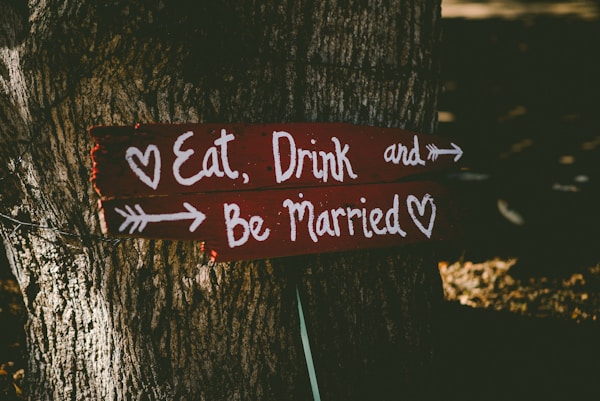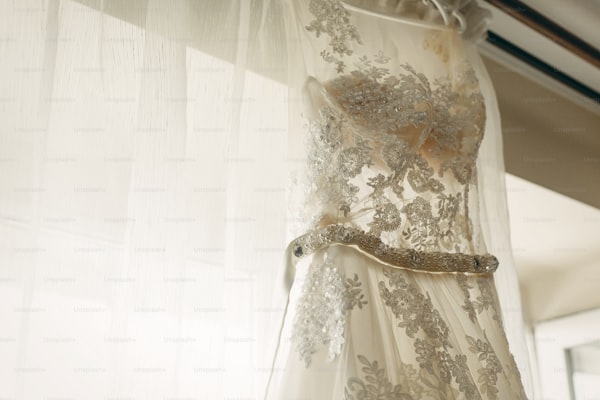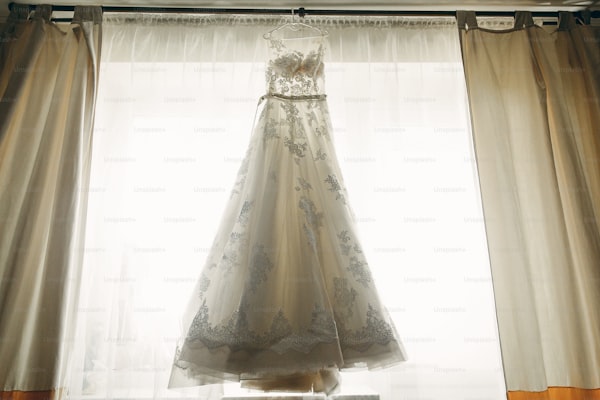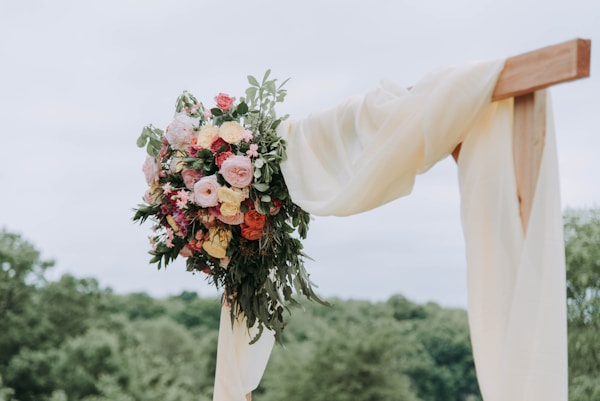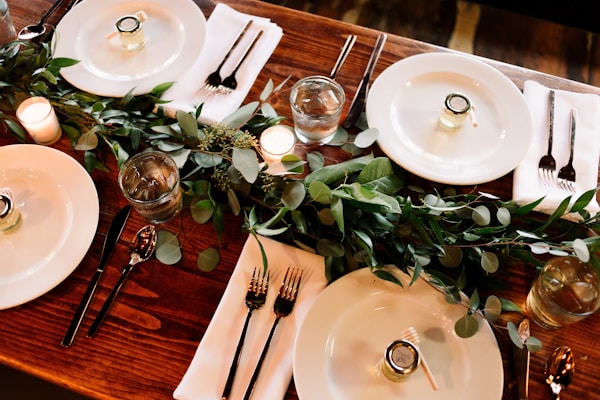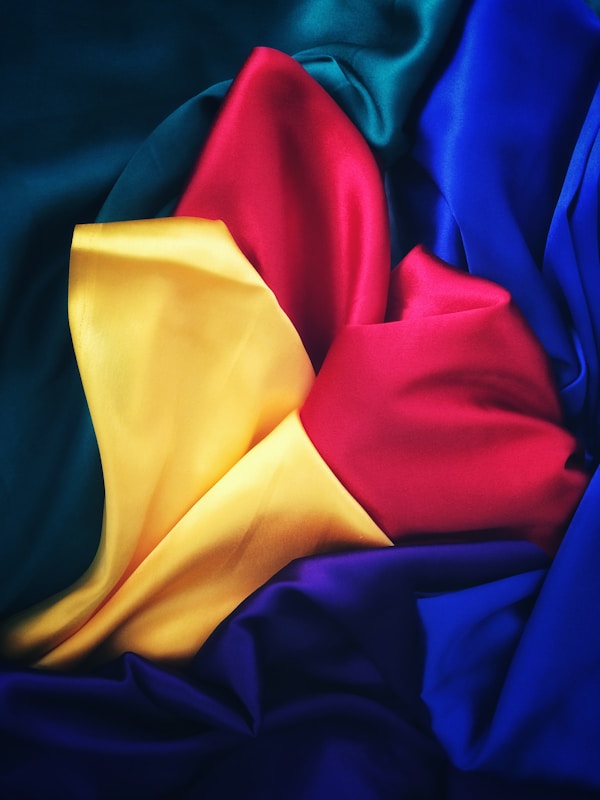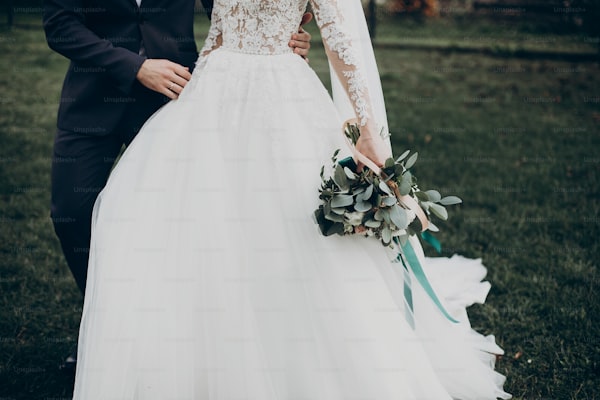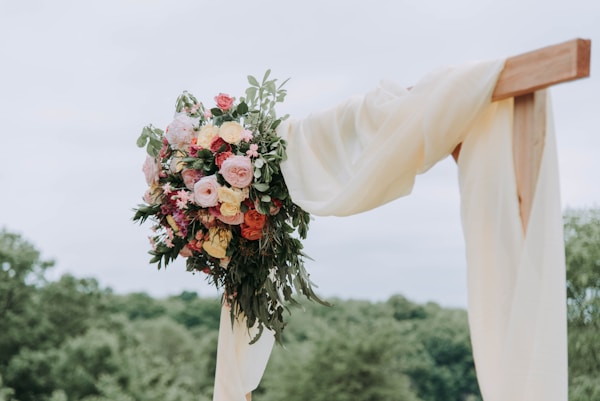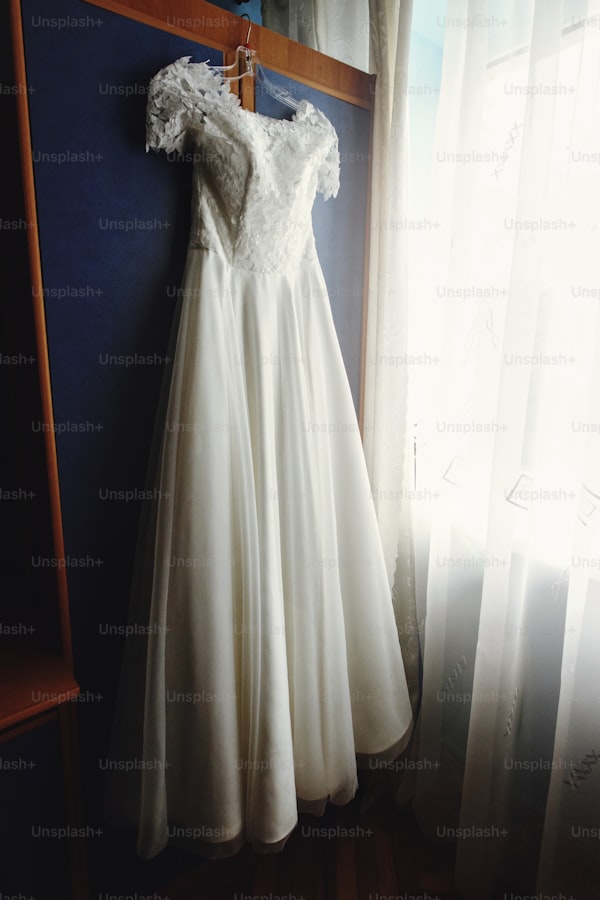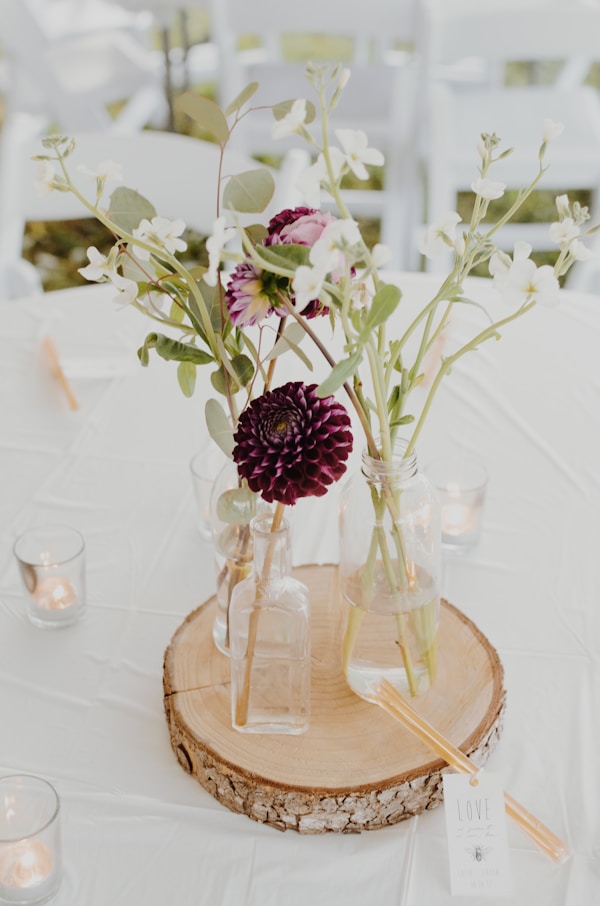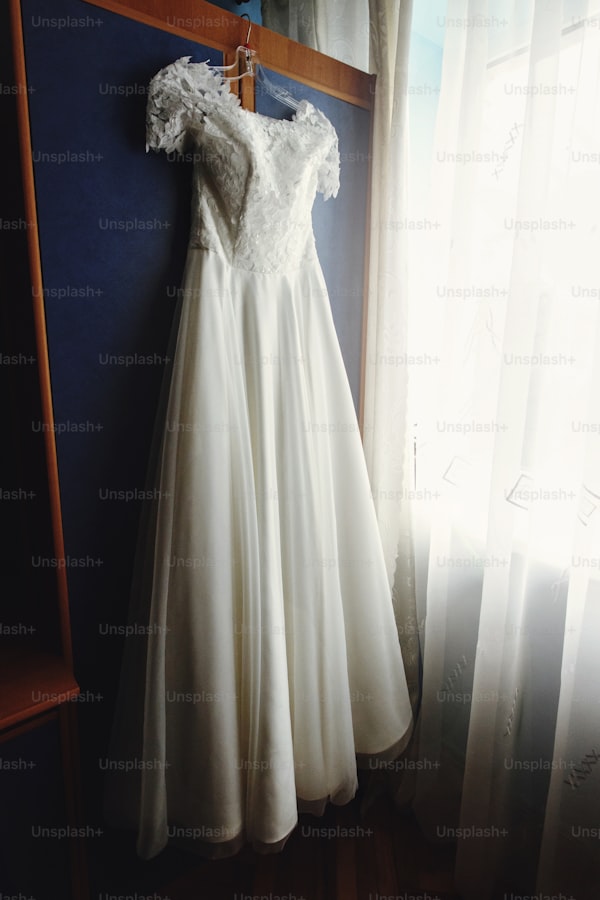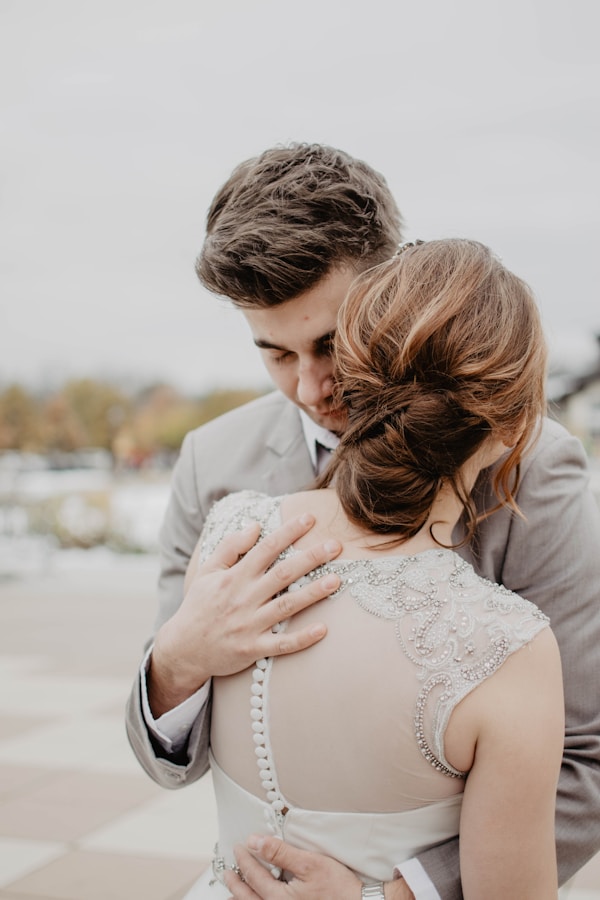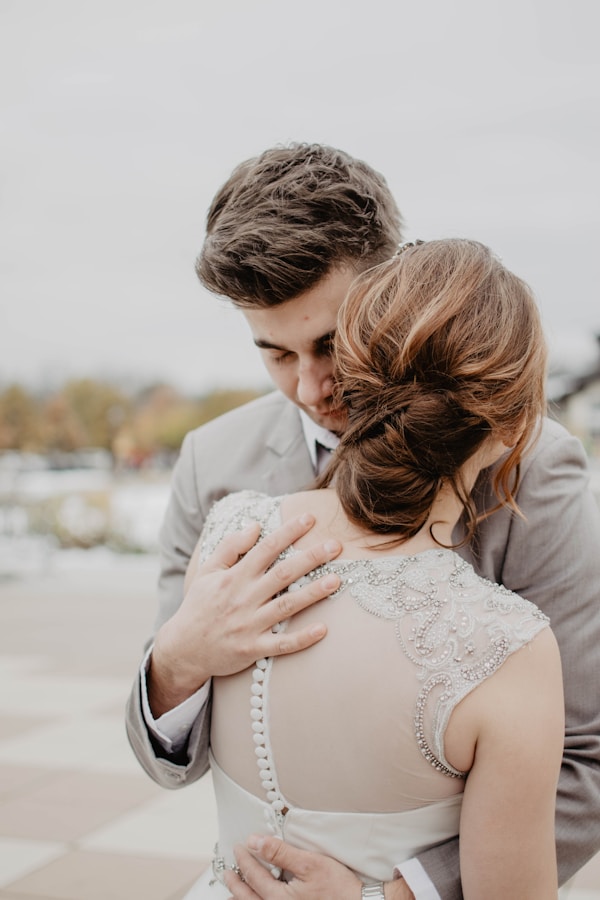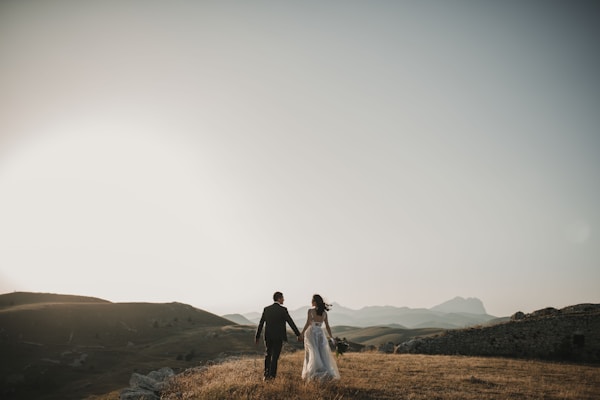Mastering Wedding Dress Alterations: How to Handle Sweetheart Neckline and Illusion Back
Planning a wedding can be both a joyous and daunting task, especially when it comes to finding the perfect wedding dress. One popular style that many brides are drawn to is the wedding dress with a sweetheart neckline and an illusion back. These designs offer a romantic and elegant silhouette that enhances the bride’s natural beauty. However, alterations for such intricate styles can be tricky. In this article, we will discuss how to handle alterations for a wedding dress featuring a sweetheart neckline and illusion back, ensuring that your dress fits flawlessly on your special day.Understanding the Sweetheart Neckline and Illusion BackThe sweetheart neckline is characterized by its curved shape, resembling the top of a heart, which accentuates the décolletage. The illusion back, on the other hand, often features sheer fabric adorned with lace, beads, or embroidery, creating a stunning visual effect while providing support and coverage.When looking to alter such a dress, it’s essential to understand how these features contribute to the overall design and fit. Here are some common concerns and questions brides might have:What type of alterations can I expect for these styles?How do I find a reliable tailor for wedding dress alterations?What are some tips for communicating with my tailor?How much should I budget for alterations?What should I do if I change sizes before the wedding?Type of AlterationsSeveral alterations may be necessary for a wedding dress with a sweetheart neck...
What Methods Are Used to Create a Wedding Dress with Cascading Layers?
Creating a wedding dress is a magical process, especially when it involves cascading layers that add elegance and movement to the gown. This article delves deep into the various methods used to design such stunning wedding dresses, no matter if you are a bride-to-be curious about your options or a designer looking to expand your skills. Let’s explore the artistic techniques, materials, and sewing methods that make cascading layers a breathtaking feature of wedding attire. The Art Behind Cascading Layers Cascading layers are characterized by the graceful overlap of fabric that flows down the dress. The delicate fall of these layers can evoke an ethereal quality, making the bride look heavenly on her special day. The methods to create such layers can be both traditional and modern, incorporating various fabrics, textures, and construction techniques. Fabric Selection The first step in crafting a wedding dress with cascading layers is selecting the appropriate fabric. Here are some popular materials used: Fabric Type Characteristics Satin Shiny, smooth, and heavy, providing structure to support layers. Tulle Lightweight and airy, perfect for creating soft, flowing layers. Chiffon Soft and sheer, adds a dreamy effect to cascading layers. Organza Thin and crisp, ideal for structured yet flowing layers. Choosing the right fabric not only influences the overall style but also determines how well the layers fall and flow. Design Techniques fo...
Discovering the Best Practices for Creating a Wedding Dress with a Detachable Overskirt
Introduction to Wedding Dress DesignCreating the perfect wedding dress is an exciting journey for many brides. As trends evolve, one stunning design feature that has gained popularity in recent years is the detachable overskirt. Not only does it provide versatility for the big day, but it also allows brides to achieve two distinct looks with one gown. In this article, we’ll explore the best practices for creating a wedding dress with a detachable overskirt, discussing materials, designs, and construction techniques that can bring your vision to life.Understanding the Detachable OverskirtA detachable overskirt is an elegant addition that can transform a wedding dress from a classic to a dramatic ensemble. With options to remove or add the overskirt during the event, brides can enjoy a tailored look for the ceremony and a more relaxed style for the reception. When designing this type of wedding dress, several factors come into play.Why Choose a Detachable Overskirt?There are several reasons why brides might opt for a wedding dress with a detachable overskirt: Versatility: Switch between styles effortlessly throughout the day. Mobility: Enjoy freedom of movement without sacrificing style. Value: Get two distinct looks for potentially lower costs than purchasing two dresses.Best Practices for Design and ConstructionCreating a wedding dress with a detachable overskirt requires thoughtful planning. Here are some best practices to consider: 1. Choose the Right Fabric ...
Designing the Perfect Wedding Dress for Dancing: Key Tips for Comfort and Style
IntroductionGetting married is one of the most significant milestones in a person's life, and the wedding dress plays a crucial role in making the day memorable. However, many brides-to-be often grapple with a pressing question: How do you design a wedding dress that allows for easy movement while dancing? This article delves into the essential aspects of creating a wedding dress that balances style, comfort, and functionality, specifically tailored for your beautiful wedding dance.Understanding Movement in Wedding DressesA wedding is filled with various activities, and dancing is often the highlight of the evening. To ensure your dress allows for free movement, it’s vital to understand the dynamics of dance and how a dress can accommodate them. Different styles, cuts, and fabrics will influence your ability to move comfortably.The Importance of Fabric ChoiceThe fabric you choose can significantly affect the ease of movement in a wedding dress. Here are some recommended materials:FabricCharacteristicsSatinSmooth and lightweight, allowing for freedom of movement.TulleLight and airy, often used for layers without feeling constrictive.LaceOffers a beautiful texture while being relatively flexible.CrepeHas a natural stretch and clings to the body, enabling smooth movements.Designing the SilhouetteThe silhouette of your wedding dress also influences how easy it is to dance in. Consider the following styles that promote movement:A-Line: Flattering for all body types, the A-line sha...
Unveiling the Secrets: What Techniques Are Used to Create a Wedding Dress with a Unique, Asymmetric Drape?
Weddings are one of the most cherished events in a person’s life, and every bride aspires to look stunning on her special day. Among the many elements that contribute to a bride’s beauty is her wedding dress. In recent years, a notable trend has emerged in bridal fashion—wedding dresses featuring unique, asymmetric drapes. In this article, we will delve into the techniques used to create these exquisite garments, ensuring that every bride feels one-of-a-kind on her big day.Understanding Asymmetric DrapingAsymmetric draping in wedding dresses is characterized by an uneven silhouette that flows elegantly across the body. This technique not only enhances the bride's figure but adds an element of modernity and artistry to traditional wedding attire. The charm of asymmetric draping lies in its ability to transform classic silhouettes into something fresh and extraordinary.The Art of DrapingDraping is a fundamental technique in fashion design, where fabric is arranged on a dress form to create a unique silhouette. This is particularly crucial for wedding dresses, as the draping can greatly affect how the gown flows and fits the bride. Key techniques in creating asymmetric drapes include:TechniqueDescriptionBias CuttingCutting fabric on the bias allows it to hug the body and create a natural drape, perfect for asymmetric designs.LayeringUsing multiple layers of fabric can create depth and add visual interest to the dress.GatheringGathering fabric at certain points creates fullness a...
Mastering the Art of Managing Production for Wedding Dresses with Custom Pearl Detailing
Introduction to Custom Pearl Detailing in Wedding DressesThe world of bridal fashion is constantly evolving, and one trend that has gained significant traction is the use of custom pearl detailing in wedding dresses. Wedding dresses adorned with exquisite pearl embellishments not only exude elegance but also reflect the unique style and personality of the bride. However, effectively managing the production process for these intricate designs can be a daunting task. In this article, we will explore various strategies and best practices that will help you streamline production while ensuring that your wedding dresses meet the highest quality standards.Understanding Custom Pearl DetailingCustom pearl detailing can range from subtle accents to statement pieces that transform an ordinary wedding dress into an extraordinary one. Pearls can be employed in various ways, including:Appliqué: Attach pearls directly to the fabric to create intricate designs.Embroidery: Sew pearls into the fabric to add texture and dimension.Beading: Use pearls in conjunction with beads for a more elaborate look.Benefits of Using Custom Pearl Detailing1. Unique Aesthetic: Custom pearls can provide a distinctive and luxurious touch that sets the dress apart.2. Enhanced Value: Dresses with elaborate detailing often command higher prices due to their craftsmanship.3. Personalization: Brides can personalize their dresses to reflect their tastes and preferences more closely.Challenges in Production ManagementM...
Unveiling the Magic: What Methods Are Used to Create a Wedding Dress with an Embellished Tulle Skirt?
When it comes to bridal fashion, the wedding dress holds a special significance, representing love, beauty, and elegance. Among the various styles of wedding dresses, those featuring an embellished tulle skirt have gained immense popularity. In this article, we will explore the methods used to create these enchanting dresses, unveiling the artistry, techniques, and trends that bring them to life.The Allure of Tulle in Bridal FashionTulle is a lightweight, mesh-like fabric often used in wedding gowns. Its ethereal quality and delicate texture make it a favored choice for brides seeking a classic yet whimsical look. An embellished tulle skirt adds depth and character, transforming a simple gown into a breathtaking statement piece.Understanding Tulle: The Fabric of ChoiceBefore diving into the methods used to create embellished tulle skirts, it's essential to understand the fabric itself. Tulle comes in various types, including:Type of TulleDescriptionBridal TulleSoft, lightweight, and ideal for creating voluminous skirts.Silk TulleLuxurious feel with a subtle sheen, perfect for upscale weddings.Stiff TulleHolds its shape better, suitable for structured designs.Methods Used to Create an Embellished Tulle SkirtThe creation of a wedding dress with an embellished tulle skirt is an intricate process that involves several techniques. Here's a closer look at some popular methods:1. Fabric SelectionThe first step in crafting a stunning wedding dress with an embellished tulle skirt is s...
Mastering Wedding Dress Alterations: How to Handle a Layered, Multi-Length Hem
Planning a wedding is an exciting yet stressful experience, and one of the most significant aspects is finding the perfect wedding dress. However, once you’ve chosen your dream dress, alterations often become necessary—especially for styles with a layered, multi-length hem. This article will guide you through the intricacies of handling such alterations, ensuring your dress fits like a glove on your big day.Understanding the Importance of Wedding Dress AlterationsWedding dress alterations are essential for several reasons. First and foremost, achieving a perfect fit enhances comfort and confidence. In a layered dress with a multi-length hem, these adjustments can greatly affect the overall look and feel. Here’s why proper alterations matter: Visual Appeal: A well-fitted dress accentuates your body shape and showcases intricate designs. Comfort: Comfort is key for enjoying your wedding day, which often lasts several hours. Functionality: Ensuring the dress allows ease of movement is critical, especially for activities like dancing.What to Consider Before Altering a Layered, Multi-Length HemBefore diving into the alteration process, it’s essential to consider several factors related to your layered, multi-length hem wedding dress:1. Fabric TypeThe fabric of your wedding dress plays a significant role in determining how alterations should be handled. Delicate fabrics like lace or chiffon require more care than sturdy materials such as satin or taffeta. Always consult yo...
Mastering the Art of Designing a Wedding Dress with a Statement Neckline
Creating a Stunning Wedding Dress: A Guide to Statement NecklinesDesigning a wedding dress is a dream for many aspiring fashion designers and brides-to-be. Among the many aspects to consider, the neckline plays a critical role in the overall aesthetic of the gown. Statement necklines have become a popular choice for modern brides, offering a unique blend of elegance and personality. In this article, we will explore the steps for creating a wedding dress with a statement neckline, ensuring you are equipped with all the knowledge needed to embark on this creative journey.Understanding Statement NecklinesBefore diving into the creation process, it’s crucial to understand what a statement neckline is. A statement neckline is any neckline that stands out due to its unconventional shape, embellishments, or design intricacies. Popular styles include: Off-Shoulder: This romantic style highlights the shoulders and collarbone. Queen Anne: A regal design featuring a high back and a sweetheart shape in the front. V-Neck: A deep v-shape that creates an elongated silhouette. Halter Neck: This style ties around the back of the neck, exposing the shoulders.Why Choose a Statement Neckline?Statement necklines can add flair to any wedding dress, allowing brides to express their individuality. They draw attention to the bride’s face and upper body, creating a bold yet sophisticated look. Furthermore, statement necklines can enhance the overall silhouette of the gown, making them a ve...
How to Ensure a Comfortable Fit for Wedding Dresses Across Various Body Types
Understanding the Importance of Comfort in Wedding Dress FittingWhen it comes to weddings, the dress is often the centerpiece of the celebration. A wedding dress not only symbolizes the union between two people but also highlights the individuality of the bride. However, one question that frequently arises is how do you ensure a wedding dress fits comfortably over multiple body types? With diverse body shapes and sizes, finding a gown that flatters all forms can be a bit challenging. This article will delve into practical tips and strategies for ensuring comfort and style, catering to the needs of all brides.The Significance of Comfort in Wedding AttireComfort is key, particularly on one of the most significant days of your life. Brides often have busy schedules filled with planning, events, and, ultimately, the wedding day itself. A gown that fits well allows for movement, ease, and confidence as you navigate through ceremonies, receptions, and dance floors. Here, we explore effective methods to ensure that wedding dresses accommodate various body types while maintaining a chic look.1. Understanding Body TypesDifferent body types require distinct approaches when it comes to fitting. Common body types include:Body TypeDescriptionRecommended StylesA-lineNarrow at the top, wider at the bottom.A-line dresses, empire waist gowns.HourglassCurvy figure with balanced proportions.Mermaid gowns, fitted silhouettes.RectangleSimilar measurements across bust, waist, and hips.Fit-and-flar...
Mastering the Art of Wedding Dress Design: Techniques for Creating a Pleated Tulle Masterpiece
Unveiling the Beauty of Pleated Tulle in Wedding DressesWhen it comes to wedding dress design, few fabrics evoke the ethereal elegance and romantic allure quite like tulle. Among the bold and artistic techniques to manipulate this delicate material, pleating stands out as a favorite choice among bridal designers. In this article, we’ll explore the meticulous techniques used to create a stunning wedding dress with pleated tulle. Additionally, we'll address related questions you might have about wedding dress construction and design.The Allure of Tulle in Bridal FashionBefore diving into the specific techniques used to create a pleated tulle wedding dress, it’s important to understand what tulle is and why it's so popular in bridal fashion. Tulle is a lightweight, sheer fabric that adds volume and structure to gowns without being overly heavy. It can be made from a variety of materials, including silk, nylon, or polyester, making it versatile for different wedding themes and budgets.Why Choose Pleated Tulle?Pleating is a technique where fabric is folded and sewn to create texture and movement in the garment. Here are a few reasons why pleated tulle is favored in wedding dress design: Texture: Pleated tulle adds visual interest and depth to the dress. Movement: The pleats create a dynamic flow, making the gown more captivating as the bride moves. Versatility: Pleating can be applied in various ways, whether for a full skirt, bodice, or sleeves.Techniques for Creating a ...
Mastering Production Quality for Wedding Dresses with Intricate Pleating
In the enchanting world of wedding dresses, every detail counts, and one of the most exquisite features is intricate pleating. The beauty of these designs comes with challenges, particularly in ensuring production quality. This article will delve into how to manage and enhance production quality for wedding dresses with intricate pleating, focusing on critical aspects of production management.Understanding the Importance of Production QualityProduction quality is essential in the fashion industry, and when it comes to wedding dresses, it takes on an even greater significance. Brides want to feel perfect, and the dress plays a crucial role in that experience. High-quality production ensures that intricate pleating maintains its intended design, fits well, and creates the right silhouette. Poor production quality can lead to significant issues, such as: Inconsistent pleating patterns that do not align as intended. Materials that do not hold the pleats over time. Unexpected alterations needed close to the wedding date, causing stress for brides.Key Strategies for Managing Production QualityTo ensure the highest standards of production quality for wedding dresses with intricate pleating, here are several strategies that designers and manufacturers can implement:1. Selecting the Right MaterialsChoosing the appropriate fabric is paramount in achieving quality in intricate pleating. Fabrics such as silk, satin, or organza are often favored due to their draping qualities and...
Exploring the Art of Creating a Wedding Dress with a Unique Bow Detail
When it comes to designing a wedding dress, every detail counts. One of the most enchanting elements that can set a gown apart is a unique bow detail. Bows can range from understated elegance to extravagant statements, making them a versatile choice for brides of all styles. In this article, we will explore the various methods used to create wedding dresses featuring this delightful detail. We will also delve into the significance of bows in the context of wedding fashion and what brides should consider when opting for this charming embellishment.The Evolution of the Bow in FashionBows have been a part of fashion history for centuries, symbolizing femininity and grace. From the grand gowns of the Victorian era to modern minimalist designs, bows make a statement. They can accentuate a waistline, add drama to a train, or bring an artistic touch to a simple silhouette. Understanding the evolution of the bow and its significance in wedding fashion can help brides appreciate this timeless detail. 1. Bow Styles & PlacementWhen designing a wedding dress with a unique bow detail, the first step is to determine the style and placement of the bow. Common styles include:StyleDescriptionClassic BowAn elegant bow tied at the back or front, often featuring long, flowing tails.Oversized BowA dramatic statement piece that can be placed on the back, creating an eye-catching focal point.Subtle BowA small, delicate bow that adds an element of charm without overwhelming the design.Layered BowMul...
Designing a Wedding Dress with a Flattering Waistline for Every Body Type
When it comes to planning the perfect wedding, one of the most significant decisions a bride will make is choosing her wedding dress. An essential aspect of this choice is the dress's waistline, as it plays a vital role in enhancing the overall silhouette and ensuring that the bride feels confident and beautiful on her big day. So, how do you design a wedding dress with a flattering waistline for different body types? This guide will take you through the essential considerations, styles, and tips to help you create the perfect gown.Understanding Body TypesEach bride has a unique body shape, and understanding these differences is the first step in designing a wedding dress that flatters. The most common body types include: Apple Shape: Characterized by a fuller upper body with slim legs, brides with this shape often fear drawing attention to their midsection. Pear Shape: Featuring a smaller upper body and wider hips, this shape benefits from styles that accentuate the waist and draw attention upward. Hourglass: Defined by equal width at the bust and hips with a defined waist, hourglass figures can flaunt their curves with various waistline styles. Rectangle Shape: Having a straight figure with similar measurements at the bust, waist, and hips, this body type can create curves with the right dress. Inverted Triangle: With broader shoulders and a narrower lower body, this shape benefits from styles that create balance.Choosing the Right Waistline StylesNow that we understan...
What Are the Best Practices for Creating a Wedding Dress with a Fitted Bodice and Mermaid Skirt?
Creating the perfect wedding dress is a dream for many brides-to-be. Among the various styles available, the fitted bodice and mermaid skirt combination stands out as a timeless choice. This design emphasizes the natural curves of the body, providing a sophisticated yet alluring silhouette. In this article, we’ll explore the best practices for creating a wedding dress with a fitted bodice and mermaid skirt, along with tips for fabric selection, design considerations, and fitting techniques.Understanding the Fitted Bodice and Mermaid SkirtBefore diving into the design process, let’s clarify what constitutes a fitted bodice and a mermaid skirt. The fitted bodice refers to a dress top that hugs the torso, creating a seamless and elegant appearance. The mermaid skirt, on the other hand, is characterized by its fitted shape throughout the hips and thighs, flaring out dramatically at or just below the knee. This style is ideal for brides looking to showcase their curves while maintaining an air of sophistication.Key Factors to ConsiderWhen designing a wedding dress with these features, several factors must be considered:Body Type: Different body types may suit different designs. Understanding your silhouette will help in creating a dress that flatters your figure.Fabric Choice: The choice of fabric plays a crucial role in how the dress will fall and fit. Materials such as satin, lace, and chiffon are popular choices for wedding dresses.Design Elements: The incorporation of design e...
Mastering Alterations for Wedding Dresses with Delicate Lace Sleeves
Your Complete Guide to Handling Wedding Dress Alterations Choosing the perfect wedding dress is an exhilarating experience for any bride-to-be. However, when it comes to alterations, especially for intricate designs like lace sleeves, many find themselves puzzled. In this article, we will delve deep into the nuances of handling alterations for a wedding dress with delicate lace sleeves, ensuring your dress fits like a glove on your special day. Understanding Wedding Dress Alterations Wedding dress alterations are essential for achieving the perfect fit. It's crucial to keep in mind that every dress is unique, and adjustments may require specialized skills, especially when dealing with delicate fabrics like lace. Here, we will discuss the most common alterations brides should consider. The Importance of Professional Tailoring While DIY alterations might seem tempting, entrusting your wedding dress to a professional tailor is advisable. A skilled tailor understands the intricacies of lace and the potential challenges of altering intricate designs. They possess the expertise to handle delicate fabrics without compromising their integrity. Types of Alterations for Wedding Dresses Here are some common alterations brides might consider for their wedding dresses, particularly those featuring delicate lace sleeves: Type of Alteration Description Hem Adjustment Altering the length of the dress to ensure it fits properly, especially for brides wearing heels. S...
Mastering the Art: Techniques to Create a Wedding Dress with a Scalloped Hemline
Wedding dresses are more than just gowns; they are symbols of love, celebration, and personal style. Among various design elements, the scalloped hemline stands out due to its elegant feel and intricate beauty. In this article, we will delve into the techniques used to create a wedding dress with a scalloped hemline, exploring artistic methods, materials, and tips to ensure every bride feels like a queen on her special day.Understanding the Scalloped HemlineThe scalloped hemline is characterized by a series of curves or semicircles along the edges of the fabric, creating a beautiful and flowing silhouette. This design detail can add texture and visual interest to the wedding dress, making it a popular choice among brides seeking something unique.Why Choose a Scalloped Hemline?One might wonder, why choose a scalloped hemline over other styles? Here are a few reasons:Elegance: The gentle curves of a scalloped hemline add a touch of sophistication.Versatility: It complements various fabrics, from lace to satin.Personalization: Brides can customize the depth and shape of the scallops to match their wedding theme.Techniques for Creating a Scalloped HemlineCreating a wedding dress with a scalloped hemline involves a combination of design techniques, sewing methods, and fabric manipulation. Below are the most effective techniques used by professional designers:1. Fabric SelectionThe first step in creating a scalloped hemline is choosing the right fabric. Fabrics like lace, chiffon, ...
Ensuring Your Wedding Dress Remains Flawless Through Multiple Fittings
How Do You Ensure a Wedding Dress Remains in Perfect Condition Through Multiple Fittings?Choosing the perfect wedding dress is an emotional journey for many brides-to-be. However, ensuring that your wedding dress remains in impeccable condition during the fitting process can be just as important. With multiple fittings ahead, it's crucial to take certain steps to maintain the dress's beauty and integrity. In this article, we will explore practical tips, expert advice, and common questions related to how to care for your wedding dress throughout multiple fittings.The Importance of Dress Care During FittingsWedding dresses are often intricate garments made from delicate fabrics, adorned with embellishments, lace, and beading. Each fitting is crucial for achieving the perfect fit, but it also poses a risk of wear and tear. Here’s why maintaining your dress through the fitting process is essential: Preservation of Fabric Quality: Delicate fabrics like silk and tulle can easily snag or get stained. Overall Appearance: Regular checks can prevent unsightly wrinkles and creases. Length and Fit Adjustments: Ensuring that any alterations do not compromise the dress's structure.Steps to Maintain Your Wedding Dress's Condition1. Choose the Right Undergarments for FittingsThe right undergarments are essential when trying on wedding dresses. Wearing the correct undergarments not only helps you get a better sense of how the dress will fit but also minimizes the need for excessive a...
Exploring Romantic Off-the-Shoulder Wedding Dresses: Methods and Inspirations
Introduction to Off-the-Shoulder Wedding DressesPlanning the perfect wedding is a dream for many, and one of the most important elements of this special day is the wedding dress. Among the many styles available, the romantic off-the-shoulder wedding dress has become a favorite among brides. This enchanting style highlights the neck and shoulders, lending a soft, elegant touch. In this article, we will delve into the methods used to create these stunning dresses and explore various inspirations that can help brides choose their perfect gown.The Allure of Off-the-Shoulder StylesOff-the-shoulder wedding dresses have been a staple in bridal fashion for decades, but their popularity has surged in recent years. This style creates a beautiful silhouette and can be both modern and classic. The off-the-shoulder design can also be adapted to different dress styles, including A-line, mermaid, and ball gown. This versatility makes it an appealing choice for many brides.Crafting the Perfect Off-the-Shoulder LookCreating a wedding dress with a romantic, off-the-shoulder style involves several methods and techniques. Designers often consider fabric choice, structure, and embellishments to ensure the dress fits well and looks stunning.MethodDescription1. Fabric SelectionChoosing lightweight materials like chiffon or lace enhances the romantic feel.2. Structured BodiceA well-fitted bodice supports the off-the-shoulder design and creates an hourglass shape.3. Layering TechniquesEmploying layer...
Mastering the Art: What Techniques Are Used to Create a Wedding Dress with a High Neckline?
Weddings are monumental occasions that deserve a dress designed to make the bride feel exquisite and confident. Among the myriad styles available, the high neckline wedding dress stands out as a symbol of elegance and sophistication. But what techniques are used to create such a stunning piece? In this article, we will explore the intricate processes that go into designing a wedding dress with a high neckline, while also providing insights into styling, fabric choices, and the latest trends. Let's delve into this beautiful world of bridal fashion!Understanding High Neckline Wedding DressesA high neckline wedding dress typically features a collar that rises above the natural collarbone, creating a modern yet timeless look. This style suits different body types and can be tailored to fit any wedding theme, from traditional to contemporary. The elegance of a high neckline often exudes an air of sophistication that many brides desire on their special day. To create such a stunning piece, designers employ various techniques.1. Fabric SelectionThe first step in any gown creation process is selecting the appropriate fabric. High neckline wedding dresses can be made from a variety of materials, including:Silk: Known for its luxurious feel, silk is a favorite among bridal designers.Lace: Lace adds texture and a romantic element, often used for the bodice.Tulle: This lightweight material is perfect for layering, frequently seen in high necklines with dramatic effects.Satin: A heavier f...
